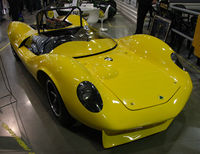Lotus 30
 | |
| Category | Group 4 Sports Car --see text |
|---|---|
| Constructor | Team Lotus |
| Designer(s) | Colin Chapman and Martin Wade |
| Technical specifications | |
| Chassis | Steel Backbone |
| Suspension (front) | Double Wishbone, Outboard Coil/Spring Damper |
| Suspension (rear) | Double Wishbone, Outboard Coil/Spring Damper |
| Engine | Ford 4,727cc 289 cu in V8 |
| Transmission | ZF 5 Speed Manual Synchromesh Limited Slip Differential |
| Competition history | |
| Notable entrants | |
| Notable drivers | |
The Lotus 30 was a racing automobile, Colin Chapman's first attempt at a large displacement sports car racing machine following the success of the smaller Lotus 19 and Lotus 23. In a way as a further development of the final Lotus 19 called Lotus 19B, which had a Ford V8 engine installed in place of Coventry Climax FPF, it was designed by Colin Chapman and Martin Wade, and built in 1964. Lotus 30 was raced in British races such as Guards Trophy, international races such as Nassau Speed Week that allowed FIA Group 4 "Sports Car" class of racing machines, and more importantly, in Can Am series. These were before the recognition and creation of Group 5, 6 and 7 categories by FIA in 1966. This explains why Lotus 30 and 40 (the latter was built in 1965) came originally equipped with headlights and a windshield wiper.
Notable were its curvaceous fibreglass body work and "pickle fork" backbone chassis first seen in the front engine Lotus Elan, in sharp contrast to Lotus 19's space frame design. On the 30, the layout was reversed and placed the engine behind the driver. Lotus engineer Len Terry was asked by Chapman to comment on the draft concept and considered it to be so flawed he refused to have anything to do with it. The Lotus 30 was powered by a 4.7 litre (289 c.i.) Ford V8 engine, the same type as used in the Ford GT40, mated to a 5 speed ZF syncromesh transaxle which was far more reliable than Colotti transaxle in 19B handling the V8 torque. It used 13 inch wheels and solid disc brakes on each wheel. The Lotus 30 was regarded as unsuccessful and / or dangerous but when everything was working and nothing broke the car was incredibly fast.
The inherent flaws of the engineering became evident as horse power requirements and tire technology of the period evolved and pushed the original design past its intended limits. The problems were mainly related to the torsional rigidity of the backbone chassis and materials available at the time, all of which resulted in chassis and suspension failures.
Jim Clark laboured long with the car, and managed to prize some promising results with it before it was replaced with the Lotus 40. Equipped with 15in wheels and vented disc brakes as well as a larger engine, the 40 was just as recalcitrant as the 30. The most telling comment about these Lotus race cars was made by the American driver Richie Ginther. When asked what he thought of the new Lotus 40, Ginther, a lugubrious Californian, said, "Same as the 30 but with ten more mistakes".
The effort was not a total loss as this chassis type proved to be perfectly acceptable for the lower powered Lotus Europa and was with development used on the Esprit series cars.




![Validate my RSS feed [Valid RSS]](valid-rss-rogers.png)















































































ไม่มีความคิดเห็น:
แสดงความคิดเห็น